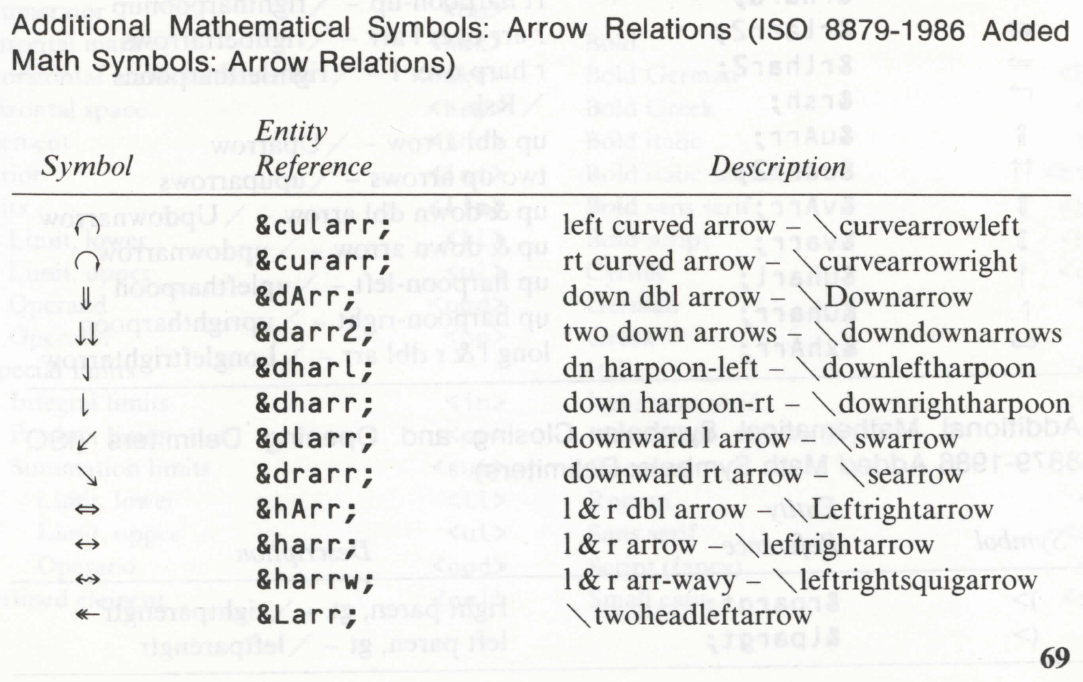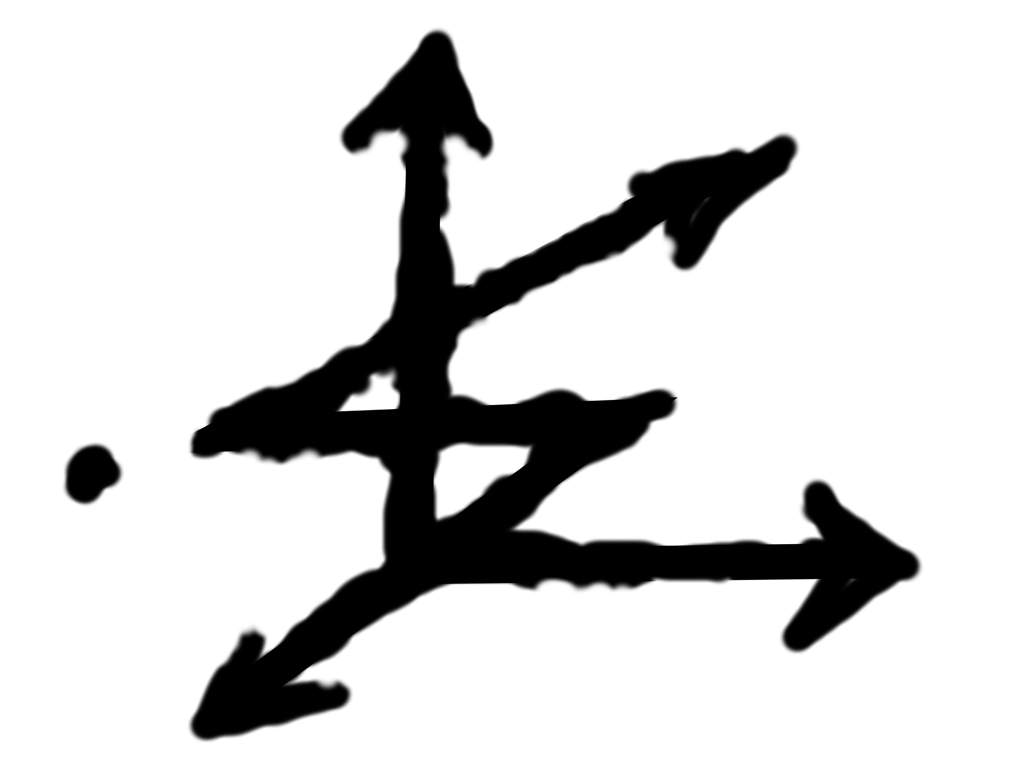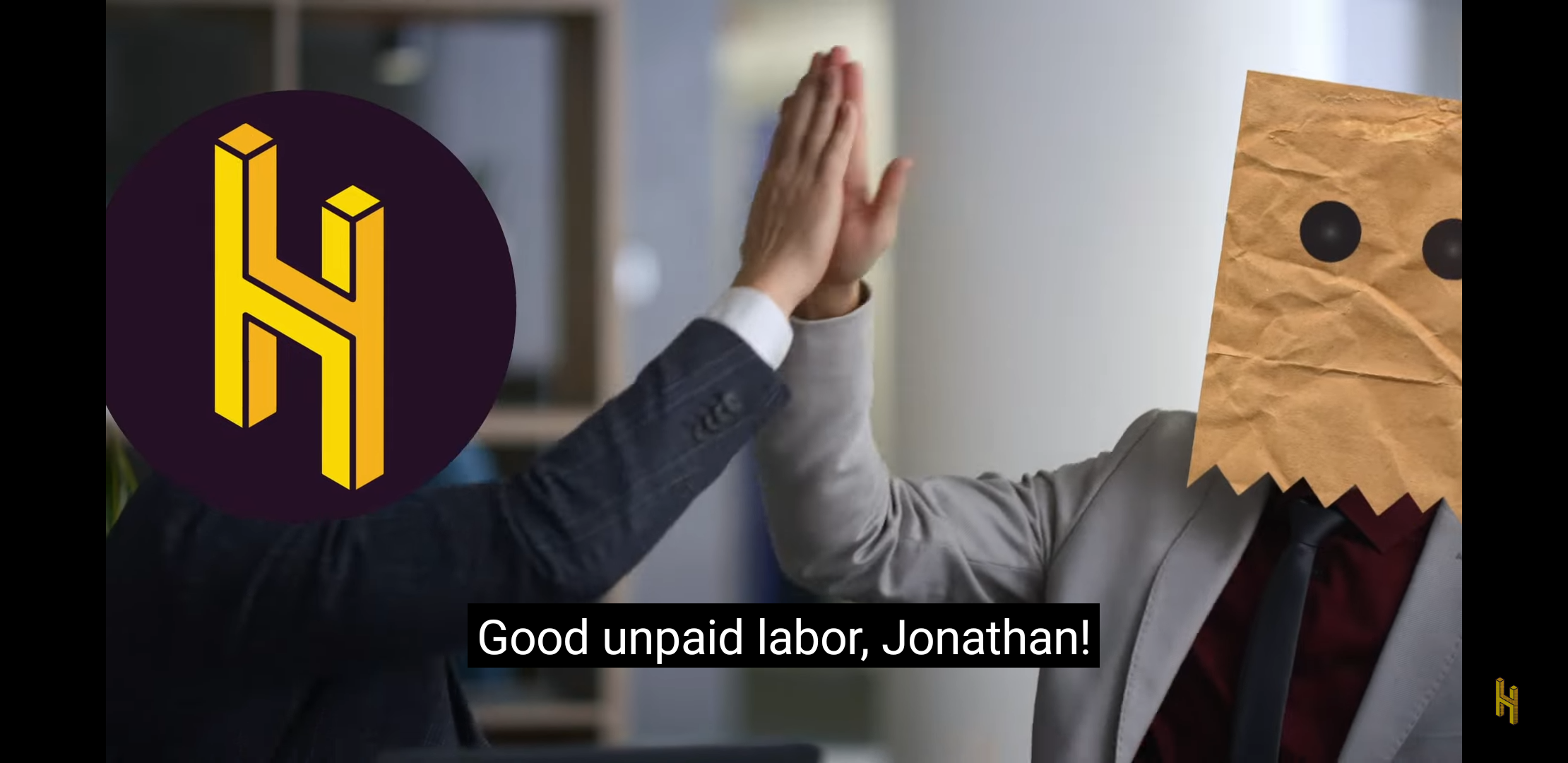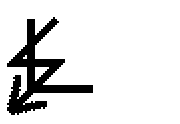
This is part 1.
Part 2: update: U+237C ⍼ angzarr;
Part 3: Monotype Mathematical Sorts
Part 4: U+237C ⍼ is (also) S9576 ⍼
Known as right angle with downwards zigzag arrow,
angle with down zig-zag arrow,
\rangledownzigzagarrow,
and ⍼,
no one knows what ⍼ is meant to represent or where it originated from.
Section 22.7 Technical Symbols
from the Unicode Standard on the
Miscellaneous Technical block
doesn’t say anything about it.
To Unicode from STIX
The original proposal that included this character is Proposal for Encoding Additional Mathematical Symbols in the BMP (N2191) from 14 March 2000, with origins from the STIX project. That project page links to a number of relevant files dating all the way back to 1997, and most importantly to the very first collation of character tables by Barbara Beeton last updated on 24 June 1997. Here we find that, in table &ac-&cirmid under codes with TR 9573 names, an entry for the character.
AFII ISO TR9573 entity ISO TR9573 description D97C ⍼ angle with down zig-zag arrow
(This table is later merged into a larger table.) A table from 18 July 1997 clarifies that these are characters from the technical report TR 9573-13. A later table from 7 Feburary 1998 with accompanying glyphs confirms that this is indeed the character we’re looking for.
Unicode Glyph SGML Name Description E248 angzarr ISOAMSA angle with down zig-zag arrow
The Unicode code point E248 is, of course, not its current actual code point. That one is located in a Private Use Area (PUA) in the Basic Multilingual Plane (BMP), and so was likely a temporary encoding within STIX before acceptance into Unicode proper. The AFII code point D97C will be explained later, as will what AFII stands for and what it is.
Related is the Mathematical Markup Language (MathML) Specification: Section 6.2.5.1 ISO Symbol Entity Sets provides the same tables as STIX, and our character can again be found in group ISO AMS-A.
ISO/IEC TR 9573-13:1991 (SGML Entity Sets)
The technical report, whose long name is ISO/IEC TR 9573-13:1991 Techniques for using SGML — Part 13: Public entity sets for mathematics and science, was published in July 1991; its editor was Anders Berglund. Although the ISO site claims there was never a newer version, there is a document with the same name last updated on 8 December 2003. It indeed lists U+237C in Section 7.1 isoamsa, but evidently this came after it was added to the Unicode Standard.

Excerpt from ISO/IEC TR 9573-13:1991, Section 5.2.5 Arrow Relations
The actual tech report itself doesn’t provide much more information than the newer document,
shown in the capture above:
all it contains is its short name, the glyph, its old code point D97C, and a description.
(If you’re a UBC student or faculty, you can get access to the
tech report via Techstreet
or here.)
The only other reference is found in Section 6.2.5 Arrow Relations,
which gives the same entity listings as
ISOasma.ent
in the Debian package sgml-data.
ISO 8879:1988 (SGML) and the AAP
The Foreword of the tech report, though, mentions that it replaces an earlier annex.
h) Part 13 replaces ISO 8879:1986 annex D (in part)
Taking a look at ISO/IEC TR 9573:1988 Techniques for using SGML as well, which people at UBC can also access via CSA onDemand as CAN/CSA-Z243.210.1-89 (R2018), it also indicates that the symbols it uses comes from ISO 8879.

Excerpt from ISO/IEC TR 9573:1988, Section 8.3 Symbols
However, this Annex D of ISO 8879:1986 Standard Generalized Markup Language (SGML) (which UBC people can again access as CAN/CSA-Z243.210-89 (R2014) via CSA onDemand or here) doesn’t contain our character, neither under ISO AMS-A as expected, nor anywhere else. This does explain the category name, at least: “AMS” here stands for “Added Math Symbols”, and has nothing to do with the American Mathematical Society.
![D.4.5.5 Arrow Relations
<!-- (C) International Organization for Standardization 1986
Permission to copy in any form is granted for use with
confirming SGML systems and applications as defined in
ISO 8879, provided this notice is included in all copies.
-->
<!-- Character entity set. Typical invocation:
<!ENTITY % ISOamsa PUBLIC
"ISO 8879-1986//ENTITIES Added Math Symbols: Arrow Relations//EN">
%ISOamsa;
-->
<!ENTITY cularr SDATA "[cularr]"--/curvearrowleft A: left curved arrow -->
<!ENTITY curarr SDATA "[curarr]"--/curvearrowright A: rt curved arrow -->
<!ENTITY dArr SDATA "[dArr ]"--Downarrow A: down dbl arrow -->
<!ENTITY darr2 SDATA "[darr2 ]"--downdownarrows A: two down arrows --> D.4.5.5 Arrow Relations
<!-- (C) International Organization for Standardization 1986
Permission to copy in any form is granted for use with
confirming SGML systems and applications as defined in
ISO 8879, provided this notice is included in all copies.
-->
<!-- Character entity set. Typical invocation:
<!ENTITY % ISOamsa PUBLIC
"ISO 8879-1986//ENTITIES Added Math Symbols: Arrow Relations//EN">
%ISOamsa;
-->
<!ENTITY cularr SDATA "[cularr]"--/curvearrowleft A: left curved arrow -->
<!ENTITY curarr SDATA "[curarr]"--/curvearrowright A: rt curved arrow -->
<!ENTITY dArr SDATA "[dArr ]"--Downarrow A: down dbl arrow -->
<!ENTITY darr2 SDATA "[darr2 ]"--downdownarrows A: two down arrows -->](/assets/images/angzarr/ISO%208879:1986.png)
Excerpt from ISO 8879:1986, Annex D.4.5.5 Arrow Relations
Annex D.4.4 Technical Use has a brief note on the origin of the names of the entities it does list, though.
NOTE — Visual depictions of most of the technical use entities are identified by their entity names in Association of American Publishers Electronic Manuscript Series: Markup of Mathematical Formulas, published by the Association of American Publishers, Inc., 2005 Massachusetts Avenue, N.W., Washington, DC 20036, U.S.A.
I obtained a second edition copy of Markup of Mathematical Formulas from the University of Victoria, which lists the same entities, also missing our character.

Excerpt from Markup of Mathematical Formulas, Appendix C Entity References for use in Mathematical Formulas
ISO/IEC 10036 (Glyph Registration) and the AFII Registry
Back in TR 9573-13, Section 5 mentions that the symbols tables contain
a glyph identifier, registered in accordance with ISO/IEC 10036. The glyph identifier is shown in decimal and hexadecimal representation;
this refers to the code point D97C/55676. While ISO/IEC 10036:1993 Procedure for registration of glyph and glyph collection identifiers (accessible as CAN/CSA-ISO/IEC 10036-01 (R2014)) only describes glyph registration, the actual 10036 registry exists online. Our character can be found among code points 556xx. In 2020, the glyph table was standardized as ISO/IEC TR 10036:2020 Registered glyph identifiers, containing the same glyphs.
55676
The registry indicates that this glyph is among thousands inherited from the Association for Font Information Interchange (AFII), established in 1987 (according to this search). They had their own registry as well, cited by ISO/IEC 10036:1996, Annex D Bibliography.
Association for Font Information Interchange (AFII) International Glyph Register, Volume 1: Alphabetic Scripts and Symbols. 1993.
The AFII is long dissolved in favour of Unicode over their glyph registry; an email from Asmus Freytag, their former president, describes its history just before dissolution. Notably, it appears that anyone could register a glyph with the AFII for a fee of 5$ to 50$ (about 8.60$ to 86$, accounting for inflation).
There doesn’t seem to be a digitized version of the International Glyph Register, but thankfully, there is a copy at the Library of Congress. Additionally, Font Technology: Methods and Tools by Peter Karow (which can be found here) includes photocopies of the first 23 pages of the register in Appendix C Glyph Identifier Register. In the Introduction, Edwin Smura, the registrar, describes its contents:
The first published document of the Association for Font Information Interchange contains a glyph identifier, at least one sample glyph shape, and a description including at least a name or title for the glyph and any significant information about the meaning or intended usage.
Unfortunately, no more information is provided by the register than is already present in ISO/IEC TR 10036.

Excerpt from the International Glyph Register, entry 331/174, AFII code point 55676
UPDATES: From Barbara Beeton
After asking on the TeX Stack Exchange about the origin and meaning of the character, Barbara Beeton herself gave a response.
I had no idea what it meant or was used for, thus assigned it a “descriptive name” when collating the symbols for the STIX project. (I still have no idea, nor can supply an example of the symbol in use.) […] it is the case that ISO 9573-13 existed long before either AFII or the STIX project were formed. […] I once asked Charles Goldfarb what the source of these entities was, but remember that he didn’t have a definitive answer.
So its appearance in AFII’s registry comes after TR 9573-13, which explains the fact that the registry was published in 1993 while the tech report in 1991, although the tech report does reference ISO/IEC 10036, whose earliest version was apparently published in 1993. It’s possible there were earlier, unpublished versions of these documents.
In a follow-up comment, Beeton says:
Although I did ask, no one was able to tell me whether there was a single source or the entities were just picked up from a number of sources.
And in reference to Half as Interesting’s video:
The information in the video is inaccurate. It fails to recognize that the inclusion of the character in the STIX collection was based on its presence in a version of ISO 9573-13 earlier than the 1991 version cited, a version which existed long before AFII was formed. So any claim that it originated with AFII is chronologically invalid.
If she was unable to find a source while actively working with AFII and STIX back in the 90s, I doubt I would be able to uncover anything new now, three decades later. Here, then, I close the book on my investigation. The meaning of ⍼ will be whatever meaning is assigned by whoever uses it next… if anyone uses it at all.
Summary Timeline
- 1983: AAP Electronic Manuscript Project begins, publishing a series that includes Markup of Mathematical Formulas
- 1986-10-15: ISO 8879 (SGML) is published, containing ISO AMS-A without ⍼, referencing Markup of Mathematical Formulas
- 1987-09-15: AFII is established
- 1987-11: Markup of Mathematical Formulas, 2 ed. is published without ⍼, referencing ISO 8879
- 1988-12: ISO/IEC TR 9573 (Techniques for using SGML) is published, referring to ISO 8879
- 1988: ISO 8879 is revised with a new Annex J
- 1988: ANSI/NISO Z39.59 (AAP Electronic Manuscript Standard) is published, based on part of the published series, likely with no entity tables
- 1991-07-01: ISO/IEC TR 9573-13 (Public entity sets for mathematics and science) is published, containing ISO AMS-A with the first verifiable occurrence of ⍼, referencing ISO/IEC 10036
- 1993-06: ISO/IEC 10036 (Glyph registration) is published
- 1993: International Glyph Register by the AFII is published, containing ⍼ with no new information
- 1994: Font Technology: Methods and Tools by Peter Karow is published, containing a short excerpt of the International Glyph Register
- 1994-09: ISO 12083 (Electronic manuscript preparation and markup) is published, based on ANSI/NISO Z39.59, with no entity tables
- 1996-07: ISO/IEC 10036 is revised, referencing the International Glyph Register
- 1997-06: The STIX project begins, taking character tables from ISO/IEC TR 9573-13
- 2000-03-14: ISO/IEC JTC1/SC2/WG2 N2191 (Proposal for Encoding Additional Mathematical Symbols) is proposed, adding ⍼ to the Unicode Standard
Addendum: The Glyph
What is the glyph supposed to look like? Obviously without a definitive source, we can’t answer this question, but we can look at what various interpretations of a downwards zig-zag arrow overtop a right angle exist, starting with a vector reproduction of the glyph in the 10036 registry, originally a 96 px × 96 px GIF and supposedly copied from AFII’s registry.

Reproduction of glyph from 10036 registry
The zig-zag in question has a horizontal middle bar, with the lower bar crossing the corner of the angle. Then we have the glyph from TR 9573-13, which is luckily available as a proper PDF with vector glyphs rather than a scanned document.

Vector glyph from ISO/IEC TR 9573-13:1991
The zig-zag in question also contains a horizontal middle bar, but the lower bar doesn’t cross the angle corner. The arrowhead has a rather unusual shape, but is in line with the arrowheads of the other glyphs. Strangely, the vertical bar of the right angle doesn’t have a consistent width. Next is a vector reproduction of the glyph from both STIX and MathML, which were originally 32 px × 32 px GIFs.

Reproduction of glyph from STIX and MathML
For some reason, the middle bar of the zig-zag is now diagonal rather than horizontal. There’s also an extra pixel at the bottom bend, and the arrow now crosses the corner of the right angle. Fun fact: the horizontal bar of the right angle is a single pixel shorter than the vertical bar. Then we have the glyph as designed in the Unicode proposal document.

Vector glyph from proposal N2191
This one just looks like a vectorized version of the previous pixellated version. I don’t think the pixellated glyph is a downsampled version of this glyph, since the arrowhead in this glyph is larger and extends beyond the angle corner.

Glyphs from GNU Unifont, STIX Two, Julia Mono, and Noto Sans Math/Symbols
These last four are examples of the character in four different fonts that provide it: GNU Unifont, STIX Two, Julia Mono, and Noto Sans Math/Noto Sans Symbols. Unifont’s glyph looks like an improved version of the pixellated version: the extra pixel is gone, both bends are the same size around the vertical bar, and the arrowhead is slightly larger and more distinguishable. STIX Two’s resembles the proposal version but with a fancier arrowhead. Julia Mono’s resembles it as well, but with more acute angles and a shorter horizontal axis. (I previously said that the bottommost bar of the zig-zag wasn’t straight, and that the vertical bar of the angle had inconsistent widths; the issue has since been resolved.) Finally, Noto Sans’ glyph doesn’t even have a zig-zag; They’ve chosen to interpret the character as a wavy arrow rather than a zig-zag arrow. All of these have an arrow crossing the right angle corner, which seems to be a distinguishing characteristic of the character.
Other links:
- What is ⍼ used for? on TeX SE and Math SE
- Twitter thread about this post
- Ellis
(
 ),
a chaos magic sigil that looks suspiciously similar to ⍼
),
a chaos magic sigil that looks suspiciously similar to ⍼ - The Assault on Reality, the origin of Ellis (referred to as the Linking Sigil)
- Hacker News, Hacker News again, Lobste.rs, and Hackaday discussions
- XKCD #2606 mentions ⍼ and its Explain XKCD entry cites this post
- Half as Interesting did a video on this post (don’t bother, it’s less than half as interesting)
- Angzarr on Wikipedia

Thanks I guess?? sldkghfhg 💀




